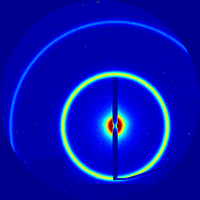Difference between revisions of "Scattering"
KevinYager (talk | contribs) |
KevinYager (talk | contribs) (→Geometry) |
||
| Line 16: | Line 16: | ||
:<math> | :<math> | ||
\begin{alignat}{2} | \begin{alignat}{2} | ||
| − | q = |\mathbf{q}| & = k \sin { \theta } \\ | + | q = |\mathbf{q}| & = k \sin { ( \theta /2 ) } \\ |
| − | & = \frac{2 \pi}{\lambda} \sin{ \theta } \\ | + | & = \frac{2 \pi}{\lambda} \sin{ ( \theta /2 ) } \\ |
| − | & = \frac{4 \pi}{\lambda} \sin{ \theta | + | & = \frac{4 \pi}{\lambda} \sin{ \theta} |
\end{alignat} | \end{alignat} | ||
</math> | </math> | ||
| + | Where <math>\scriptstyle 2 \theta </math> is the scattering angle. | ||
==Theory== | ==Theory== | ||
Revision as of 16:00, 28 August 2015
Scattering broadly refers to experimental techniques that use the interaction between radiation and matter to elucidate structure. In x-ray scattering, a collimated x-ray beam is directed at a sample of interest. The incident x-rays scatter off of all the atoms/particles in the sample. Because of the wavelike nature of x-rays (which are simply high-energy photons; i.e. electromagnetic rays), the scattered waves interfere with one another, leading to constructive interference at some angles, but destructive interference at other angles. The end result is a pattern of scattered radiation (as a function of angle with respect to the direct beam) that encodes the microscopic, nanoscopic, and molecular-scale structure of the sample.
Geometry
We define a vector in reciprocal-space as the difference between the incident and scattered x-ray beams. This new vector is the momentum transfer, denoted by q:
The length of this vector is:
Where is the scattering angle.
Theory
The mathematical form of scattering is closely related to the Fourier transform. The sample's realspace density distribution is Fourier transformed into an abstract 3D reciprocal-space; scattering probes this inverse space. The fundamental equation in scattering is:
Where the observed scattering intensity (I) in the 3D reciprocal-space (q) is given by an ensemble average of the intensity for all (N) scattering entities probed by the beam. The wave-matter interaction is given by inner term, which coherently sums (interferes) the complex scattering contributions ( denotes the scattering power) of the N entities; the exponential term represents a plane wave (incident radiation). In integral form (for a continuous function of the scattering density ), we can write an integral over all of real-space:
The inner component can be thought of as the reciprocal-space:
This is mathematically identical to the (three-dimensional) Fourier transform.








